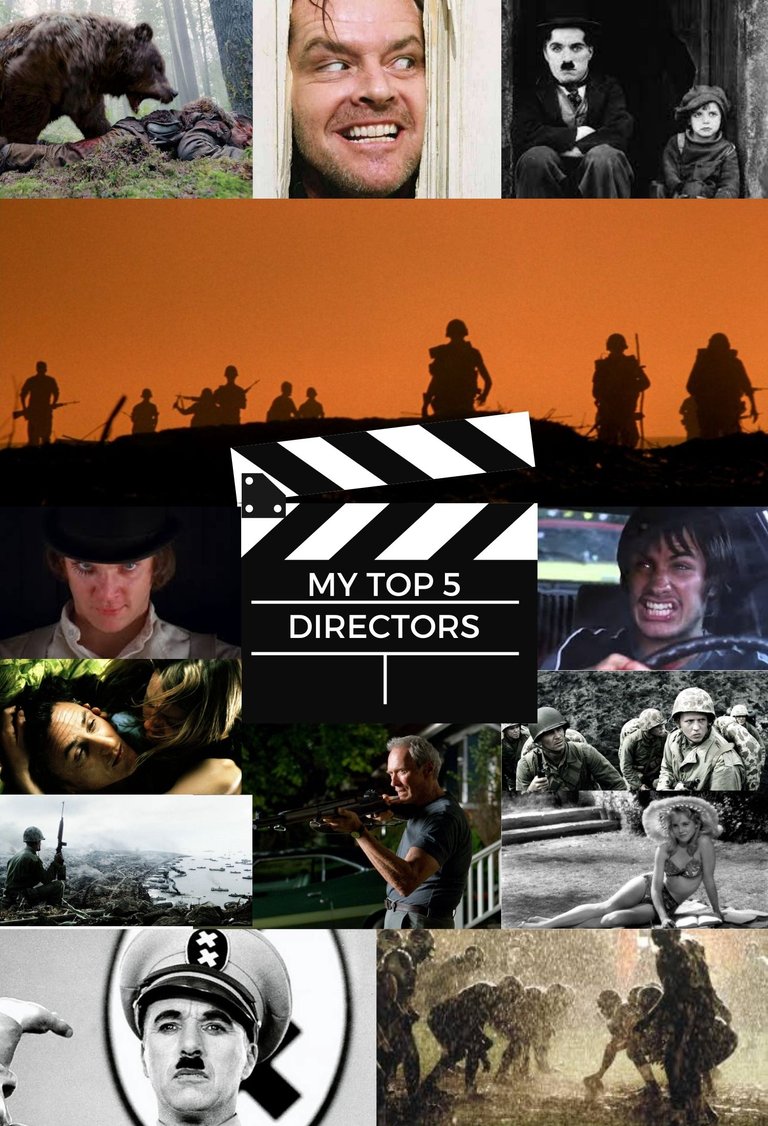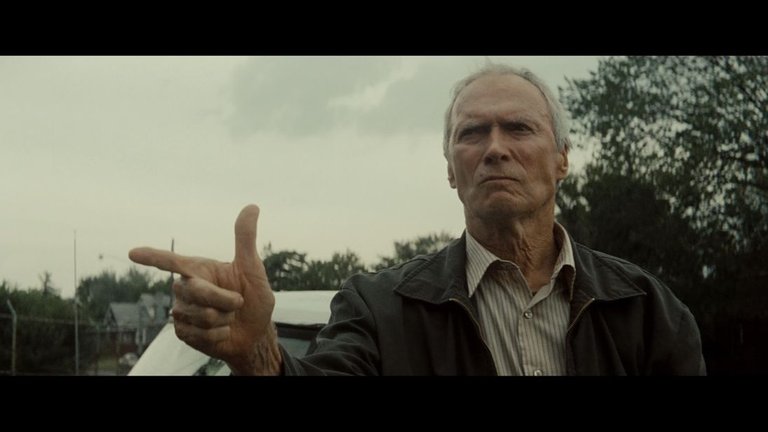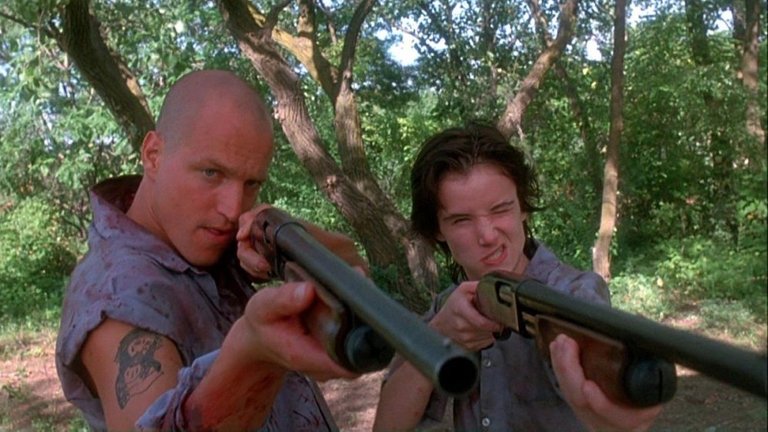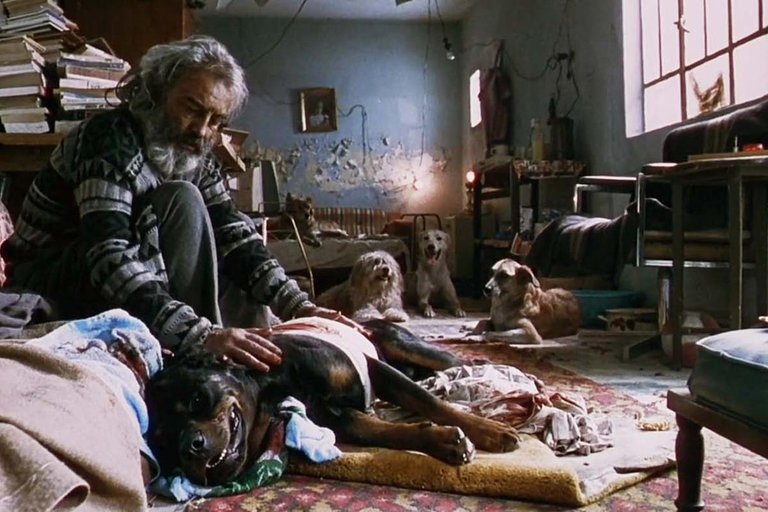
I can't choose just one.
I love cinema too much and I love it in different ways and for many reasons. That's why it's impossible for me to talk about ONE favorite director. Because there are many who have impacted my vision of art, beauty or the way of telling stories, leaving me teachings, intense emotions or simply the enjoyment of a well-made work.
From its silent beginnings until today, much water has flowed under the bridges and there are many figures who have earned a place in the history of this wonderful art. However, making an effort to summarize the sources of my love for cinema, I managed to reduce the list to five directors, based on the aspects I enjoy the most when I watch movies. Needless to say, this is a very personal assessment with no pretensions of objectivity or definitive truth. That's why I'd love to hear about your list in the comments. That said, let's get down to business.
No puedo escoger solo uno.
Amo demasiado el cine y lo amo de distintas maneras y por muchas razones. Por eso es imposible para mí hablar de UN director favorito. Pues son muchos los que han impactado mi visión del arte, la belleza o la forma de contar historias, dejándome enseñanzas, emociones intensas o simplemente el disfrute ante una obra bien hecha.
Desde sus inicios mudos hasta hoy, ha corrido mucha agua bajo los puentes y son muchas las figuras que se han ganado un lugar en la Historia de este maravilloso arte. Sin embargo, haciendo un esfuerzo por resumir las fuentes de mi amor por el cine, logré reducir la lista a cinco directores, basándome en los aspectos que más disfruto cuando veo películas. Sobra decir que es una apreciación muy personal sin pretensiones de objetividad o verdad definitiva. Por eso me gustaría saber sobre tu lista en los comentarios. Dicho esto, vayamos al grano.

Charles Chaplin
I think Chaplin represents a true creative peak of the first age of cinema, because he loved this art so much that he absorbed the trends, technical resources and artistic visions of his time and turned them into truly immortal works that are still as relevant as they are beautiful today. The silent film era bequeathed us great directors to whom we are still indebted, but I think that in Chaplin's films we can see them all; from the expressive resources of Murnau, the editing skills of Eisenstein to the photographic daring of Keaton, Griffith or Alice Guy; everything can be appreciated in the work of this genius, who not only directed, wrote and starred in his films, but also composed the music for most of them and since 1916 also produced them.
Physical comedy, simple but no less marvelous camera tricks, first class acting and well thought out shots and movements, resulted in a language very rich in its expressive and narrative capabilities, impacting the world of cinema with a legacy that remains alive in our days. My favorites of his filmography are The Gold Rush (1925), Modern Times (1936) and The Great Dictator (1940), which was his first sound film. From this last one I would like to share the wonderful final speech, anti-war and anti-fascist, with which Chaplin bravely denounced the insane nightmare to which Hitler, Musolini and Franco subjected the peoples of Europe. It is worth noting that this film was released a year before the United States became involved in World War II.
Charles Chaplin
Creo que Chaplin representa una verdadera cumbre creativa de la primera edad del cine, pues tanto este arte como para absorber las tendencias, los recursos técnicos y las visiones artísticas de su tiempo y volcarlas en verdaderas obras inmortales que hoy siguen siendo tan vigentes como hermosas. La época del cine mudo nos legó grandes directores con los que seguimos en deuda, pero pienso que en las películas de Chaplin podemos verlos a todos; desde los recursos expresivos de Murnau, las habilidades de montaje de Eisenstein hasta los atrevimientos fotográficos de Keaton, Griffith o Alice Guy; todo puede apreciarse en el trabajo de este genio, que no sólo dirigió, escribió y protagonizó sus películas, si no que compuso la música de buena parte de ellas y desde 1916 también las produjo.
Comedia física, trucos de cámara simples, pero no por ello menos maravillosos, un manejo actoral de primera y planos y movimientos muy bien pensados, resultaron en un lenguaje muy rico en sus capacidades expresivas y narrativas, impactando al mundo del cine con un legado que permanece vivo en nuestros días. Mis favoritas de su filmografía son La quimera del oro (1925), Tiempos modernos (1936) y El Gran Dictador (1940), la cual fue su primera película sonora. De ésta última quiero compartir el maravilloso discurso final, antibelicista y antifascista, con el que valientemente Chaplin denunció la demencial pesadilla a la que Hitler, Musolini y Franco sometían a los pueblos de Europa. Cabe destacar que esta película se estrenó un año antes de que los Estados Unidos se involucrara en la II Guerra Mundial.
Escena de El Gran Dictador (1940)
Satanley Kubrick
I like everything about Kubrick. His career left us only 13 feature films in almost five decades; but among them are true gems that marked the path of their genres, sparked controversy and inspired many artists around the world. Kubrick is perhaps the most influential filmmaker of his generation; his technical quality and profound gaze produced memorable sequences and shots that remain fixed by fire in the viewer's eyes.
In chronological order, my three favorites are: Spartacus (1960), scripted by Dalton Trumbo and starring Kirk Douglas, Lawrence Olivier and Peter Ustinov among others, earned many awards and nominations around the world, including four Oscars and a Golden Globe. 2001 A Space Odyssey (1968), a Science Fiction gem, based on a short story by Arthur C Clark, who co-signed the screenplay with Kubrick. In addition to directing it, Kubrick produced it and, even today, the film is still considered one of the best films of its kind in history. And finally, A Clockwork Orange (1971), a controversial film in which Kubrick explores violence and the forms of social domination in which it finds its cause and meaning. Because of its violent, sexual and critical content, it was (and still is) one of the most controversial and risky titles of this author.
Kubrick's legacy includes other fundamental titles for modern cinematography, such as Lolita (1962), Barry Lyndon (1975), The Shining (1980), Full Metal Jacket (1987) and Eyes Wide Shut (1999), but my personal selection remains with the three mentioned above.
Satanley Kubrick
De Kubrick me gusta todo. Su carrera nos dejó apenas 13 largometrajes en casi cinco décadas; pero entre ellas se encuentran verdaderas joyas que marcaron el camino de sus géneros, desataron la polémica e inspiraron a muchos artistas alrededor del mundo. Kubrick es tal vez el cineasta más influyente de su generación; su calidad técnica y profunda mirada produjeron secuencias y planos memorables que se fijan a fuego en la mirada del espectador.
En orden cronológico, mis tres favoritas son: Espartaco (1960), con guión de Dalton Trumbo y las actuaciones de Kirk Douglas, Lawrence Olivier y Peter Ustinov entre otros, se hizo merecedora de muchos premios y nominaciones en todo el mundo, incluyendo cuatro Oscars y un Globo de Oro. 2001 Odisea del Espacio (1968), una joya de la Ciencia Ficción, basado en un cuento de Arthur C Clark, quien firmó junto a Kubrick el guion. Además de dirigirla, Kubrick la produjo y, aún hoy, el filme se sigue considerando una de las mejores películas de la historia en su género. Y, finalmente, La Naranja Mecánica (1971), un polémico film con el que Kubrick explora la violencia y las formas de dominación social en la que ésta encuentra su causa y significado. Por su contenido violento, sexual y crítico, fue (y sigue siendo) uno de los títulos más polémicos y arriesgados de este autor.
El legado de Kubrick incluye otros títulos fundamentales para la cinematografía moderna, como Lolita (1962), Barry Lyndon (1975), El Resplandor (1980), Full Metal Jacket (1987) y Ojos bien cerrados (1999), pero mi selección personal se queda con las tres arriba mencionadas.
Secuencia: El Amanacer del Hombre. 2001 Odisea del Espacio (1968).
Clint Eastwood
Clint Eastwood is perhaps the artist in whose evolution we can register how the love for an Art can make you shed your skin, evolve and reinvent yourself to make of your vision and expression true works worthy of universal acclaim. He emerged from the Spaghetti-Westerns directed by a (by then) unknown Sergio Leone, earning fame as an anti-hero and badass gunslinger that he would consolidate with the character of Harry Callahan, the lone detective known as Dirty Harry. In the early 1970s Eastwood began to direct, telling increasingly complex and richly nuanced stories that transcended archetypes and humanized the easy "heroism" of their protagonists.
Whether through big shots and epic battle sequences or through minimalist photography focused on the actors' expressions, Eastwood shows us the development of an intelligent look in love with his craft, as well as a unique sensitivity that contrasts with the " tough macho " image to which he accustomed us from his early works. His magnificent cinematographic taste is also evident in the music of his films, in many of which he figures as composer. In 2005, with The Million Dollar Baby, Easwood became, at 78, the oldest person to direct two Oscar-winning films for Best Picture.
My favorites of this Master Filmmaker are: The Million Dollar Baby (2005), a sports drama where Eastwood shows how much and well can be said with little. Flag of Our Fathers (2006), which together with Letters from Iwojima shows us an alternative and more personal vision to the epic narrative of World War II in the Pacific. And Gran Torino (2008) another masterpiece that brings us closer from an almost intimate vision to the misunderstandings of mature age with a reality far away from the ideal of life that was sold to his generation, revealing the human, sacrificed and resilient side of a protagonist with many layers under a rough and sullen appearance. Again, there are many more that deserve to be seen and have garnered awards and critical acclaim, but these are mine.
Clint Estwood
Clint Eastwood es tal vez el artista en cuya evolución podemos registrar como el amor a un Arte puede hacerte mudar de piel, evolucionar y reinventarte para hacer de tu visión y expresión verdaderas obras dignas de la aclamación universal. Emergió de los Spaguetti-Western dirigidos por un (para entonces) desconocido Sergio Leone, ganándose la fama como antihéroe y pistolero duro que consolidaría con el personaje de Harry Callahan, el solitario detective conocido como Harry El Sucio. A comienzos de los 70 Eastwood empezó a dirigir, contando historias cada vez más complejas y ricas en matices que trascendían los arquetipos y humanizaban el “heroísmo” fácil en sus protagonistas.
Bien sea a través de grandes planos y épicas secuencias de batallas o mediante una fotografía minimalista centrada en la expresión de los actores, Eastwood nos muestra el desarrollo de una mirada inteligente y enamorada de su oficio, a parte de una sensibilidad única que contrasta con la imagen de “macho duro” a la que nos acostumbró desde sus primeros trabajos. Su magnífico gusto cinematográfico se manifiesta también en la música de sus películas, en mucha de las cuales figura como compositor. En 2005, con La Chica del Millón de Dólares, Easwood se convirtió a los 78 años en la persona más longeva en dirigir dos filmes ganadores del Oscar a Mejor Película.
Mis favoritas de este Maestro del Cine son: La Chica del Millón de dólares (2005), un drama deportivo donde Eastwood demuestra lo mucho y bien que se puede decir con poco. La Bandera de Nuestros Padres (2006), que junto a Cartas de Iwojima nos muestra una visión alternativa y más personal a la narrativa épica de la Segunda Guerra Mundial en el Pacífico. Y Gran Torino (2008) otra obra de arte que nos acerca desde una visión casi intimista a los desencuentros de la edad madura con una realidad ajena al ideal de vida que le vendieron a su generación, revelándonos el lado humano, sacrificado y resiliente de un protagonista con muchas capas debajo de una ruda y huraña apariencia. De nuevo, hay muchas más que merecen ser vistas y han cosechado premios y aclamación de la crítica, pero estas son las mías.
 Still from Gran Torino (2008)
Still from Gran Torino (2008)Fotograma de Gran Torino (2008)
Oliver Stone
Stone is a multifaceted director capable of setting the standard in every genre he dares to explore with his films. If I had to sum up why I like his work so much, I would do it with one word: Provocative. Stone seeks to make the viewer reflect, be surprised and move out of the comfort zone with an audacious and at the same time careful approach to his stories. Whether in biopics like The Doors (1990) or W (2008), his looks at the Vietnam War with Platoon (1986), Born on the Fourth of July (1988) and Heaven and Earth (1993), epic tales like Alexander (2004), historical fiction dramas like JFK (1991) or sports dramas with the quality of Any Given Sunday (1999), this director always makes use of a large repertoire of visual resources, with the precision and cleanliness of an experienced craftsman, seeking to move the viewer towards engagement with his story.
In addition to the aforementioned Born on the Fourth of July and Any Given Sunday, my trio of favorites by this author is completed with Natural Born Killers (1994), a crazy satire full of violence and black humor in which Stone revises and adapts an original script by Quentin Tarantino, with a luxury cast, headed by one of my favorite actors, Woody Herrelson.
His work as a documentary filmmaker has received divided critics and he has often been accused of being complacent with his interviewees. Personally, I think Stone is more convincing (and successful) in denouncing the contradictions and immoralities of the system in fictions such as Wall Street or Any Given Sunday than in his long interviews with Fidel Castro or Vladimir Putin. But I suppose that, in his long work of spinning an audiovisual memory of the controversial history of the 20th century, the inclusion of these voices antagonistic to the American status quo has special importance for him.
Oliver Stone
Stone es un director multifacético capaz de sentar cátedra en cada género que se atreve a explorar con sus películas. Si tuviera que resumir por qué me gusta tanto su trabajo lo haría con una palabra: Provocador. Stone busca que el espectador reflexione, se sorprenda y se mueva de su zona de confort con un abordaje audaz y al mismo tiempo cuidadoso de sus historias. Ya sea en biopics como The Doors (1990) o W (2008), sus miradas sobre la Guerra de Vietnam con Pelotón (1986), Nacido el 4 de Julio (1988) y El Cielo y la Tierra (1993), relatos épicos como Alexander (2004), dramas de ficción histórica como JFK (1991) o dramas deportivos de la calidad de Un domingo cualquiera (1999), este director siempre hace uso de un gran repertorio de recursos visuales, con la precisión y limpieza de un experimentado artesano, buscando mover al espectador hacia el compromiso con su historia.
Además de las ya mencionadas Nacido el 4 de Julio y Un domingo cualquiera, mi trío de favoritas de este autor se completa con Asesinos por naturaleza (1994), una loca sátira repleta de violencia y humor negro en la que Stone revisa y adapta un guion original de Quentin Tarantino, con un reparto de lujo, encabezado por uno de mis actores favoritos, Woody Herrelson.
Su faceta como documentalista ha recibido críticas divididas y no pocas veces ha sido señalado de complaciente con sus entrevistados. En lo personal, creo que Stone se muestra más convincente (y exitoso) al denunciar las contradicciones e inmoralidades del sistema en ficciones como Wall Street o Un domingo cualquiera que en sus largas entrevistas a Fidel Castro o Vladimir Putin. Pero supongo que, en su largo trabajo de hilar una memoria audiovisual de la controvertida historia del siglo XX, la inclusión de estas voces antagónicas al status quo norteamericano tiene especial importancia para él.
 Still from Natural Born Killers (1994)
Still from Natural Born Killers (1994)Fotograma de Asesinos por Naturaleza (1994)
Alejandro González Iñárritu.
This solvent director is, in my opinion, the great renovator of Latin American cinema, despite the fact that he has only made two films in Spanish (both nominated for Best Foreign Picture in their time). González Iñárritu is to Hispanic American cinema what García Márquez, Cortázar or Carlos Fuentes were to the Spanish-language novel. His first three films, Amores Perros (1999), 21 Grams (2003) and Babel (2005) take the "Crossed Stories" technique almost to the limit, producing a "temporal splitting" effect reminiscent of the ruptures of temporal planes in the new contemporary novel, with a clear influence of Pulp Fiction, especially in the first of them.
With only six feature films in his career, he has four Oscars to his credit; two as director, one as screenwriter and one as producer, four Golden Globes, four Bafta awards, two at the Cannes Film Festival and one at the Venice Film Festival, among other awards. His influence and importance for the current state of Cinematographic Art is recognized worldwide, to the point that in 2019 he became the second Latin American to preside over the jury of the Cannes International Film Festival. Before González Iñárritu, the only Latin American to hold the position was none other than Miguel Ángel Asturias in 1970.
My favorites of this essential filmmaker: Amores perros (1999), his debut feature; in it he explores, with a sharp and stark vision, the society of the capital city in his native Mexico and opens what he called his Trilogy of Death. 21 Grams (2004), the second film in the trilogy, in which the performances of Sean Penn, Naomi Watts and Benicio del Toro complement a story very well told from converging plot threads in an accidental tragedy. And, finally, The Revenant (2015), an impressive visual manifesto, with interesting photographic perspectives that move fluidly between the imposing landscape, the story being told and the expressions and sufferings of the characters, led by an impeccable Leonardo DiCaprio, who would be deserving of an Oscar for his performance.
Alejandro González Iñárritu.
Este solvente director es, a mi juicio, el gran renovador del cine latinoamericano, a pesar de que solo ha rodado dos películas en español (ambas nominadas a Mejor Película Extranjera en su momento). González Iñárritu es al cine hispanoamericano lo que García Márquez, Cortázar o Carlos Fuentes significaron para la novela en español. Sus tres primeras películas, Amores Perros (1999), 21 Gramos (2003) y Babel (2005) llevan casi al límite la técnica de las “Historias Cruzadas”, produciendo un efecto de “desdoblamiento temporal” que recuerda a las rupturas de planos temporales en la nueva novela contemporánea, con una clara influencia de Pulp Fiction, sobretodo en la primera de ellas.
Con apenas seis largometrajes en su carrera, tiene en su haber cuatro premios Oscars; dos como director, uno como guionista y uno como productor, cuatro Globos de Oro, cuatro premios Bafta, dos del Festival de Cannes y uno en el Festival de Venecia, entre otros reconocimientos. Su influencia e importancia para la actualidad del Arte Cinematográfico es reconocida en todo el mundo, al punto que en 2019 se convirtió en el segundo latinoamericano en presidir el jurado del Festival Internacional de Cannes. Antes de González Iñárritu, el único latino en ostentar el cargo fue nada menos y nada más que Miguel Ángel Asturias en 1970.
Mis favoritas de este imprescindible del cine: Amores perros (1999), su ópera prima; en ella explora, con visión aguda y descarnada, la sociedad capitalina de su México natal y abre la que llamó su Trilogía de la Muerte. 21 gramos (2004), segunda película de la trilogía, en la cual las actuaciones de Sean Penn, Naomi Watts y Benicio del Toro complementan una historia muy bien contada a partir de hilos argumentales convergentes en una tragedia accidental. Y, finalmente, El Renacido (2015). Un impresionante manifiesto visual, con interesantes perspectivas fotográficas que se mueven fluidamente entre el imponente paisaje, la historia que se cuenta y las expresiones y padecimientos de los personajes, encabezados por un impecable Leonardo Di Caprio, quien se haría merecedor del Oscar por su actuación.
 Still from Amores Perros (1999)
Still from Amores Perros (1999)
What about you? Tell me about your favorite directors and their films in the comments to continue celebrating good cinema. Until next time Hivers.
PS: The collage for the cover image was made in Canvas from stills from films by the five directors.
¿Y qué hay de ti? Cuéntame acerca de tus directores favoritos y sus películas en los comentarios para seguir celebrando el buen cine. Hasta la próxima Hivers.
PS: El collage para la imagen de portada lo realicé en Canvas a partir de fotogramas de películas de los cinco directores.

